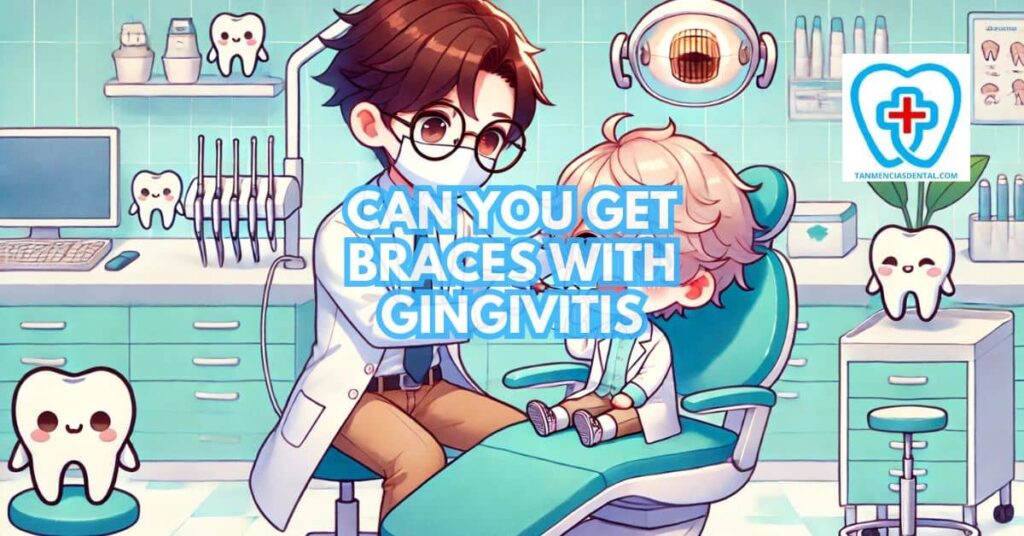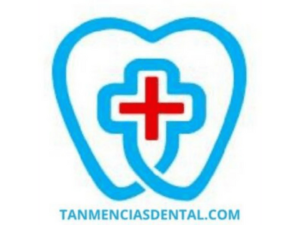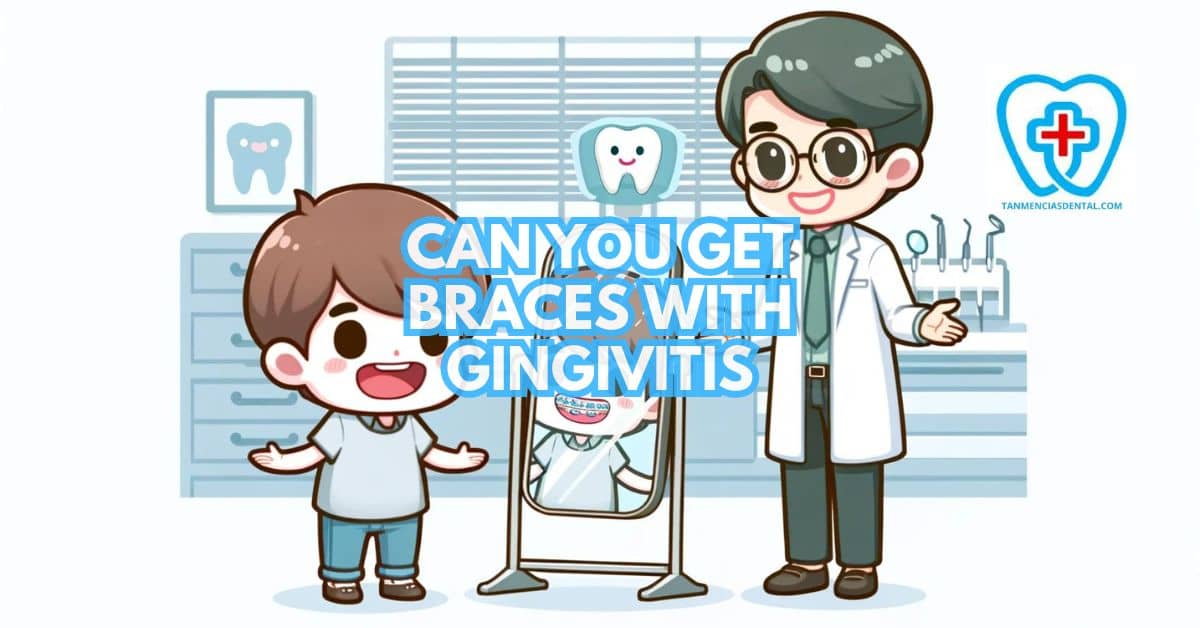Getting braces can help straighten your teeth, but if you have gingivitis, you might be wondering if it’s still possible.
Can you get braces with gingivitis?
The answer is yes, but it’s important to take extra care of your gums before and during treatment.
Braces can make it harder to clean your teeth, which can make gingivitis worse if not properly managed.
You’ll learn how to treat gingivitis before getting braces, how to keep your gums healthy with braces, and what new orthodontic technologies can help make the process easier.
1. Understanding Gingivitis: The Basics of Gum Inflammation
Gingivitis is an early stage of gum disease that causes inflammation, redness, and swelling of the teeth and gums.
It develops when plaque, a sticky film of bacteria, builds up on the teeth and irritates the gums.
If not removed through a proper cleaning routine, plaque hardens into tartar, making it even harder to keep the gums healthy.
Common symptoms include bleeding gums when brushing, persistent bad breath, and gum tenderness.
If left untreated, gingivitis can progress to periodontitis, a more severe condition that may lead to tooth loss.
People undergoing braces treatment need to be especially careful, as braces create more surfaces for plaque to accumulate.
A strong oral hygiene routine, including brushing, flossing, and regular dental checkups, is essential for preventing and managing gingivitis effectively.
🦷 Can Custom Toothbrushes Help People with Limited Dexterity?
2. Braces and Gingivitis: Can You Still Get a Straighter Smile?
Yes, you can still get braces if you have gingivitis, but it requires careful management.
Your orthodontist will evaluate the condition of your gums and determine the best course of action.
Often, a period of treatment for gingivitis will be recommended before starting braces.
This ensures that your gums are healthy enough to handle the additional care that braces require.
With proper treatment, you can achieve a straighter smile without compromising your gum health.
🦷 Why Do Dental Crowns Fail and How to Prevent It
3. New Braces Technology: How It Helps If You Have Gingivitis
Modern orthodontics has introduced braces that improve oral hygiene and reduce gum irritation.
Self-ligating braces use special clips instead of rubber bands, making it harder for plaque and food particles to get trapped around brackets.
Digital treatment planning allows orthodontists to design a precise plan, reducing unnecessary pressure on teeth and gums.
Some braces now use smoother materials that cause less friction, which helps prevent gum inflammation.
Since braces create more surfaces for plaque to accumulate, it is important to brush and floss carefully every day.
Water flossers and interdental brushes can help clean around brackets and wires more effectively.
With these advancements, braces are now safer and more comfortable for people who need to manage gingivitis while straightening their teeth.
🦷 Why Implant Abutments Matter for Long-Term Health
4. Why Gingivitis Matters More With Braces: Increased Risk and Prevention
Braces can make it more difficult to maintain oral hygiene, increasing the risk of gingivitis.
The brackets and wires create more surfaces for plaque to accumulate, which can exacerbate gum inflammation.
Therefore, preventing gingivitis while wearing braces involves a stricter oral hygiene routine.
This includes brushing after every meal, using interdental brushes, and rinsing with an antiseptic mouthwash.
Regular dental checkups are also crucial to monitor and manage any potential issues.
🦷 Top Dental Tips to Boost Your Child’s Smile

5. Getting Your Gums Prepped: Treating Gingivitis Before Braces
Before getting braces, it’s essential to treat any existing gingivitis to prevent further complications.
Your dentist will likely begin with a consultation to examine your gums and determine the best treatment plan.
A professional cleaning can help remove plaque and tartar buildup, reducing the risk of decay and gum inflammation.
If gingivitis is more advanced, procedures like scaling and root planing may be needed to clean below the gumline and prevent periodontal disease.
Untreated gum problems can lead to swelling, bleeding, and even bone loss, making braces less effective in aligning your teeth.
Strengthening your gums before orthodontic treatment ensures that they can handle the pressure braces put on your teeth.
Taking these steps before getting braces helps protect your oral health and improves the chances of a successful treatment outcome.
🦷 Why Choosing the Right Abutments Matters for Implants
6. Brushing Up Your Routine: Oral Hygiene Tips for Braces and Gingivitis
Maintaining oral hygiene with braces requires extra effort, especially if you have gingivitis.
Brush your teeth at least twice a day with a soft-bristled toothbrush and fluoride toothpaste.
Use interdental brushes or floss threaders to clean between your teeth and around the braces.
Incorporate an antiseptic mouthwash into your routine to help reduce plaque and bacteria.
Consistency in these practices is key to preventing gingivitis and maintaining healthy gums.
🦷 Why Do Some People Feel Pain During Dental Cleanings?
7. Diet for Healthy Gums: What to Eat (and Avoid) for Gingivitis
Your diet plays a significant role in managing gingivitis and supporting overall gum health.
Include plenty of fruits and vegetables in your meals, as they provide essential nutrients for healthy gums.
Avoid sugary foods and drinks, as they can contribute to plaque buildup and worsen gum inflammation.
Sticky and hard foods should also be limited, as they can be challenging to clean from braces and may damage the brackets.
A balanced diet supports your oral hygiene efforts and helps keep your gums in good condition.
🦷 Can I Brush After Teeth Whitening?
8. Staying on Track: The Importance of Regular Checkups With Braces
Regular dental checkups are vital when you have braces and gingivitis.
Your dentist can monitor your gum health and adjust your treatment plan as needed.
These visits allow for professional cleanings to remove any plaque that you might miss during your daily routine.
Early detection of any issues ensures prompt treatment and helps prevent more severe problems.
Staying on track with regular checkups is a crucial part of maintaining healthy gums and achieving a successful orthodontic outcome.
🦷 What to Expect from Teeth Whitening in the Philippines
9. Warning Signs: When Gingivitis With Braces Needs Attention
It’s important to recognize the warning signs that indicate that gingivitis is worsening while you have braces.
Persistent swelling, bleeding gums, and pain are key symptoms to watch for.
If you notice these signs, it’s crucial to contact your dentist immediately.
Ignoring these symptoms can lead to more severe gum disease and complicate your orthodontic treatment.
Prompt attention can help manage the condition effectively and prevent further issues.
🦷 Why Implants with Bridges Are Ideal for Missing Teeth
10. Alternative Options: Exploring Other Paths to a Straight Smile
If gingivitis is severe, traditional braces might not be the best option for you.
Clear aligners, such as Invisalign, can be a viable alternative as they are removable and easier to clean.
Other orthodontic treatments, like lingual braces or ceramic braces, might also be considered.
Discuss these options with your orthodontist to find the best solution for your specific situation.
Exploring these alternatives ensures that you can still achieve a straight smile without compromising your gum health.
🦷 Periodontal Surgery in Marikina: Expert Care You Can Trust
11. A Smile Worth Fighting For: Achieving Oral Health With Braces
Achieving a healthy, straight smile is a worthwhile goal, even if you have gingivitis.
It requires dedication to maintaining excellent oral hygiene and following your dentist’s recommendations.
Regular checkups and professional cleanings are essential to monitor your gum health and the progress of your braces.
By committing to these practices, you can successfully manage gingivitis and achieve the smile you desire.
Remember, your efforts will lead to a healthier mouth and a more confident smile.
🦷 Skilled Dentists Offering Care in Marikina
👨⚕️ Conclusion
Managing gingivitis while wearing braces is challenging but entirely possible with the right approach.
Follow your dentist’s advice, maintain rigorous oral hygiene, and attend regular checkups.
These steps are crucial for keeping your gums healthy and ensuring the success of your orthodontic treatment.
With dedication and proper care, you can navigate this journey successfully.
Ultimately, you’ll achieve both a healthier mouth and a beautifully straight smile.
😊 Self-Promotion
Visit Tan-Mencias Dental Clinic in Parang, Marikina City, for all your dental needs!
Our friendly team is ready to provide top-notch care in a welcoming environment.
For questions or to book an appointment, you can call us at 9171451074, send a message through our Facebook page, or contact us via our website.
We’re here to make your dental experience pleasant and stress-free.
Your smile is our priority, and we look forward to seeing you soon!

